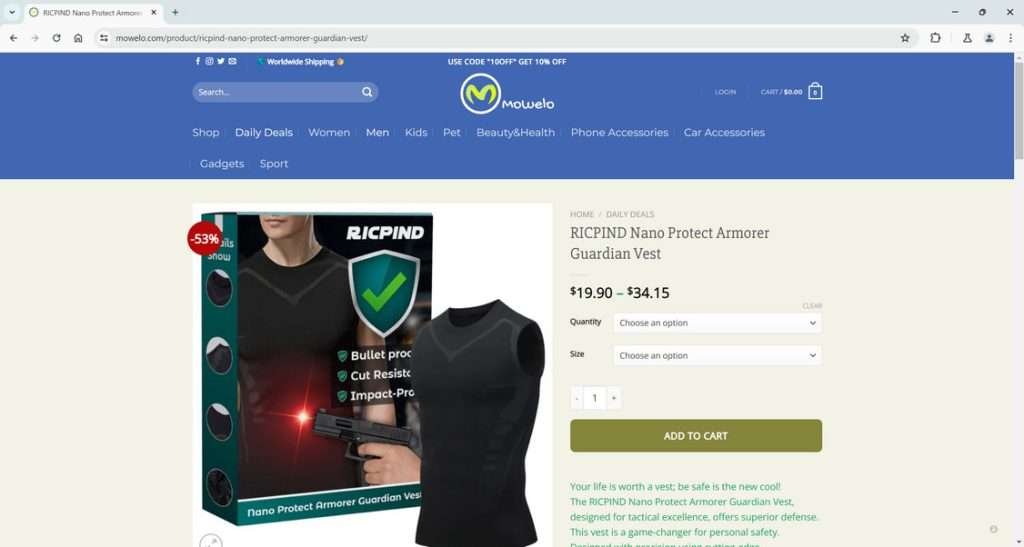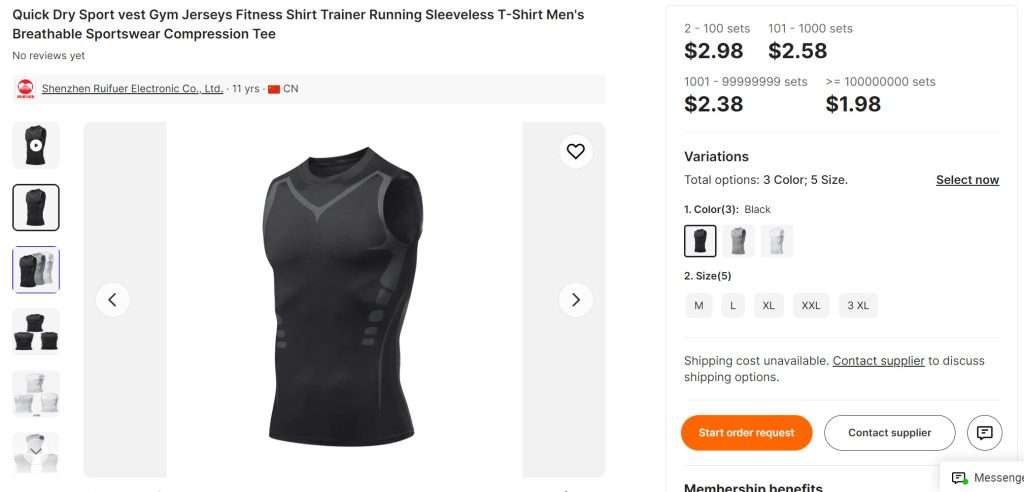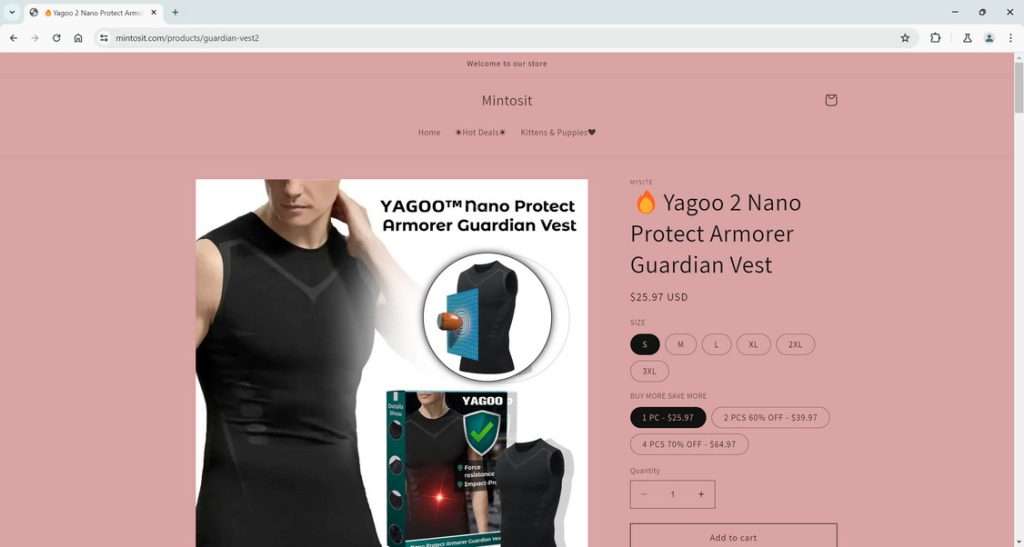A new personal protection scam is sweeping the internet, tempting victims with claims of a revolutionary bulletproof and knife-proof vest. Online ads promote the supposed “RICPIND Nano Protect Armorer Guardian Vest” as a tactical gear breakthrough, using terms like “nanotechnology” and “superior strength” to entice buyers. However, this article will expose how it is all an elaborate ruse designed to steal people’s money.
This investigation will uncover the truth behind the RICPIND Nano Protect Armorer Guardian Vest scam. We’ll explain how their deceptive ads work, detail what victims really receive, and advise those who unfortunately fell for the false claims.

This Article Contains:
Overview of the RICPIND Nano Protect Armorer Guardian Vest Scam
The supposed “RICPIND Nano Protect Armorer Guardian Vest” being promoted online is actually a complete scam designed to deceive worried consumers seeking enhanced personal safety.
Behind the convincing videos and scientific-sounding marketing lies a harsh reality – the so-called “bulletproof vest” that gets shipped is nothing but a cheap polyester tank top that provides no real protection.

This bait-and-switch fraud capitalizes on vulnerabilities by exaggerating claims of revolutionary nanotechnology and superior bullet resistance. In truth, the $19 to $89 products shipped are just flimsy athletic shirts easily penetrated by blades or projectiles.
The devious scammers utilize every psychological trick, from fake scarcity to bogus claims of exceeding safety standards, to generate sales. Images of models wearing the gear and touting its life-saving capabilities aim to manufacture credibility.
After receiving financial information, the fraudsters rapidly deliver worthless, off-the-shelf tank tops, denying refunds to maximize profits. They expertly cover their tracks, avoiding accountability for these outright deceptive practices targeting individuals in search of security.
With flashy videos as bait, polished websites to close the sale, and barriers to refunds in place, this heartless scam ensnares countless concerned consumers. The scheme rakes in untold thousands from victims who can least afford to lose money or take risks with subpar protective equipment.
These scammers demonstrate no ethics, profiting from falsified safety claims and people’s basic desire to shield themselves in an unstable world. Their only motive is greed, directly contrasted against the sense of security they disingenuously sell.
Next, let’s break down exactly how scammers carry out this scam from start to finish.
How the RICPIND Nano Protect Armorer Guardian Vest Scam Deceives Victims
The RICPIND Nano Protect Armorer Guardian Vest scam operates through a devious multi-stage process that transforms skepticism into false trust. This cunning scheme preys on disaster preparedness fears to sell imaginary protection solutions.
Stage 1: Dramatic Social Media Ads
The scam starts with sponsored social media ads showcasing sensational video dramatizations. These flashy videos portray regular people taking direct point-blank gunshots without getting harmed, thanks to the supposed life-saving power of the RICPIND Nano Protect Armorer Guardian Vest.
The intense scenes display pistols, rifles, shotguns, and other firearms unsuccessfully penetrating the vest at close range. Equally vivid stabbing scenes show knives harmlessly bouncing off the vest’s material without leaving a mark on the actor.
These exaggerated demonstrations aim to spark intrigue and override critical thinking, making the unbelievable protection seem real. The outlandish claims of stopping bullets and blades overwhelm rational analysis.
Stage 2: Slick Sales Pages
Interested viewers get directed from the dramatic ads to polished sales pages that reinforce the false claims. These scam sites use persuasive language, stock photos of models, science-like terminology, and fake reviews to further legitimize the illusion.
For example, the sites use terms like “nanoweaave,” “tensile polyfibers,” and “multi-impact absorption matrix” to portray the vest as cutting-edge. Images depict stylish-looking men and women confidently wearing the gear. And paid reviews convey satisfaction with the vest’s supposed capabilities.
These tactics work to overcome wariness in potential buyers.
Stage 3: Psychological Triggers
Skilled scammers expertly leverage various psychological motivators to convert visitors into paying victims.
- False scarcity creates urgency and demand (“Only 2 vests remaining!”)
- Countdown timers pressure quick impulse buys
- Upsells encourage overspending for “bundle” packages
- Peer pressure is applied via phony testimonials and claims of popularity
- Buzzwords feed fantasies of tactical gear
- Discounts and sales incentivize immediate purchase
The mind games and minimal critical thinking lower defenses, making the bait more enticing.
Stage 4: Outrageous Product Claims
The sites portray ridiculously exaggerated capabilities of the basic polyester vests they ship out. Some claims include:
- Stopping all handgun, shotgun, and rifle rounds up to .50 caliber
- Tested against over 100 firearms and blades
- Slash/stab-proof against 15+ knife strikes
- Thinner than Kevlar but 5x stronger
- Withstanding grenades, landmines, and shrapnel
- Nanotech construction more durable than steel
- Wearable 24/7 for complete risk protection
These and other absurd, unproven claims strongly contradict the cheap athletic shirts sent to victims. But they spark desire and false confidence to drive sales.
Stage 5: Securing Payments
The final step sees victims complete their orders via credit card or Paypal, getting charged up to $90 per vest.
Once payments are secured, cheap polyester workout tops costing a few dollars get shipped. Logos and inserts maintain the sophisticated vest illusion.
Stage 6: Blocking Refunds
As expected, swindled customers immediately demand refunds upon realizing the deceptive bait-and-switch. But automated responses dismiss complaints, claiming they simply failed to follow the product’s use instructions.
Threats of legal action or credit card chargebacks get ignored or answered with further stonewalling and red tape. The operators work relentlessly to prevent refunds and retain profits.
In summary, the RICPIND Nano Protect Armorer Guardian Vest scam uses calculated psychological manipulation and suppression of refunds to successfully deceive those allured by the dramatic marketing. An elaborate but deceitful presentation that exploits those letting their guard down. Staying vigilant is key to avoiding their traps.
Scammers Rebrand the Same Scam Vest Under Different Names
One devious tactic used by the fraudsters behind the RICPIND Nano Protect Armorer Guardian Vest scam is rebranding the same worthless product under a rotating cast of fictional company names.
While “RICPIND Armorer Guardian” is one prominent scam brand, some other names being used to promote the same phony bulletproof vest scam include:
- Nano Protect Armorer Guardian Vest
- iRosesilk Nano Protect Armorer Guardian Vest
- Yagoo Nano Protect Armorer Guardian Vest
And numerous other constantly changing pseudo-brands and product names.


The scam ads and websites closely follow the same template each time, simply swapping in the latest fictitious branding. They recycle the same outlandish capabilities, using familiar phrases like:
- “Military-inspired, exceeding safety standards”
- “Precision-fit without restricting mobility”
- “Nanotech-infused for superior strength”
- “Ideal for robust defense in various situations”
But the products shipped remain cheap $3 polyester tank tops clearly offering no real protective qualities.

This rebranding strategy allows scammers to continue their bait-and-switch operation, avoiding negative reviews associated with any one name. Consumers should watch for the telltale signs of exaggerated marketing claims and unrealistic low prices.
No matter the new branding, these scammers cannot hide the fact they are promoting worthless athletic shirts while promising hi-tech body armor. Buyers should constantly exercise skepticism to protect themselves.
What To Do If You Are a Victim of the RICPIND Nano Protect Armorer Guardian Vest Scam
If you’ve fallen prey to the false claims and purchased the bogus RICPIND Nano Protect Armorer Guardian Vest advertised online, take the following steps to respond:
- Immediately Demand a Refund: Contact the scammers firmly requesting an immediate and full refund. Provide proof of the deceptive product received that does not match advertisements. Be persistent and escalate to management.
- File Complaints: Submit detailed fraud complaints with the FTC, BBB, state attorneys general, and other consumer protection agencies. Provide copies of ads, emails, product received, etc. The more claims filed, the more likely authorities can take action.
- Dispute the Credit Card Charges: Call your credit card company or bank to report the RICPIND transaction as fraudulent. Request a chargeback and provide evidence of the scam. Act quickly, as discharge dispute time limits apply.
- Leave Online Reviews: Expose the scam by writing detailed negative reviews about your experience on seller sites, social media, and consumer sites like TrustPilot. Prevent others from falling victim.
- Warn Social Networks: Report scam ads and accounts to the social platforms like Facebook that hosted them, requesting their swift removal so no one else gets deceived.
- Research Reputable Gear: Carefully vet any body armor purchases via established manufacturers with certified lab testing and credentials. Avoid impulse buys based on social media ads or testimonials. Your life is worth the extra diligence.
- Monitor Accounts: Keep checking bank and credit accounts used on suspicious sites for any signs of misuse or fraud from compromised payment info. Notify institutions ASAP of suspicious activity.
- Seek Legal Counsel: Consulting an attorney on possible civil or criminal legal remedies against the scammers may be advisable, especially if the fraud was substantial. They can advise on options.
- Get Counseling if Needed: Seek guidance from a counselor or therapist if this experience caused lasting emotional distress or trauma. You are the victim here – don’t blame yourself. Focus on recovery
While the law is making efforts to combat these scams, your best protection is still vigilance. But should you fall victim, make your voice heard and help bring accountability.
Frequently Asked Questions About the RICPIND Nano Protect Armorer Guardian Vest Scam
1. What is the RICPIND Nano Protect Armorer Guardian Vest scam?
The RICPIND Armorer Guardian scam is a deceptive bait-and-switch scheme marketed online. Scammers advertise a revolutionary nanotech bulletproof vest, but send a cheap polyester tank top costing a few dollars instead. Victims pay exorbitant prices up to $90 for this worthless shirt.
2. How does the RICPIND bulletproof vest scam work?
Scammers run dramatic ads on social media showing the vest stopping bullets. Tricked users click these ads and are directed to realistic websites exaggerating the vest’s capabilities. These sites use tricks to compel visitors to purchase quickly. Victims receive just a plain workout shirt, while refunds are denied by the scammers profiting from deception.
3. What capabilities do the scammers claim about the RICPIND Nano Protect Armorer Guardian Vest?
The scam sites falsely claim capabilities like stopping all handgun and rifle rounds, resisting multiple knife attacks, exceeding military standards, using advanced nanomaterials, and more. In reality, the basic tank tops shipped provide no protection at all.
4. What do victims of the scam receive in the mail?
Despite paying huge sums, victims receive just thin polyester athletic shirts similar to cheap workout gear. These are sometimes branded with “RICPIND” logos to maintain the illusion, but provide no bulletproof or defensive capabilities whatsoever.
5. What is the actual value of the items shipped to scam victims?
The flimsy polyester tops shipped to victims of this scam are worth no more than a few dollars each when purchased wholesale. Scammers make huge profit margins by charging $100+ for these near-worthless shirts.
6. How much does the RICPIND Nano Protect Armorer Guardian Vest scam cost victims?
Scammers charge between $19 to $90 per vest, though the items shipped have an actual value under $3. Many victims are manipulated into buying multi-item packages, costing them hundreds for cheap shirts.
7. Can victims get a refund after being scammed?
Refunds are intentionally made nearly impossible by the scammers. Automated messages reject refund requests. Threats of legal action and credit card chargeback often face resistance or stonewalling as well from these shady fraudsters.
8. Where are RICPIND Nano Protect Armorer Guardian Vests advertised online?
Social platforms like Youtube and Facebook host many scam ads for RICPIND Nano Protect Armorer Guardian Vests. Scammers also create realistic-looking sites advertising the fictional bulletproof vests. Avoid all sources promoting this bait-and-switch scam.
9. Are RICPIND Nano Protect Armorer Guardian Vests available in retail stores?
No. RICPIND is a fake brand name used exclusively online by scammers. No physical stores sell these fictional bulletproof vests. All sites are purely scam operations to steal money via deception.
10. How can I avoid the RICPIND Nano Protect Armorer Guardian Vest scam?
Avoid all ads marketing unbelievable bulletproof vests, especially at low costs. Check seller reputations thoroughly before purchasing any tactical gear. Real manufacturers will demonstrate certified protective capabilities. Trust your instincts – if claims seem exaggerated, they likely are.
The Bottom Line
In conclusion, the supposed RICPIND Nano Protect Armorer Guardian Vest marketed online as a bulletproof miracle is just another scam predicated on brazen deception and theft. Outrageous claims minus any real demonstration of stopping bullets should instantly raise red flags.
No nanomaterial vest breakthrough exists that is so cheap, convenient, and discreet as these swindlers portray. Legitimate protective gear requires extensive safety testing and certification – not social media ads using special effects.
Your life is worth more than lining the pockets of scammers peddling imaginary wares. Exercise extreme caution when evaluating anything that sounds too good to be true, especially involving topics as serious as one’s personal security. Through prudent skepticism and scrutiny, we can cut off the ability of these charlatans to so unethically exploit people’s fears and desires for profit.










